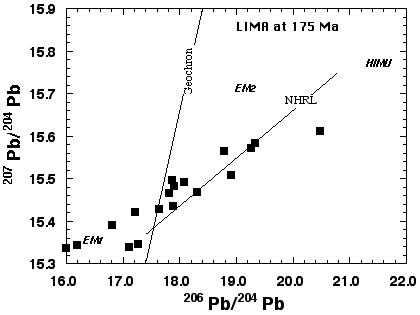Hf, Pb and Sr isotopes in LIMA from the Jagersfontein kimberlite: In-situ analysis by LAM-MC-ICPMS
W.L. Griffin1,2, N.J. Pearson1, S.E. Jackson1, M. Zhang1, S. Y. O'Reilly1 and Z. Wang3
1GEMOC Macquarie
2CSIRO Exploration and Mining
3Geologisk Inst., Univ. of Uppsala, Sweden
Introduction: Ba-K-Zr-Cr titanates of the lindsleyite-mathiasite (LIMA) group occur in heavy-mineral concentrates and as metasomatic phases in mantle-derived peridotite xenoliths in the 86 Ma Jagersfontein kimberlite, South Africa [1]. LAM-ICPMS analyses of mathiasite show high concentrations of Sr (5000 ppm), Hf (1000 ppm), Nd (250 ppm), Pb (100 ppm), U (550 ppm) and Th (60ppm).
Methods: We have analysed Hf, Sr and Pb isotopes in-situ in 2-3 mm grains of mathiasite, using a Merchantek EO UV (266 nm) Nd:YAG LAM and a Nu Plasma multi-collector ICPMS, to constrain the origin of the fluids from which the LIMA minerals grew. Data were collected in static mode using time-resolved analysis. 2-6 spots/grain were analysed for each system; quoted uncertainties are 2sd. Hf-isotope measurements were carried out in a single cycle and corrected for Lu and Yb overlap as in [2]. With ablation pits ca 150 µm in diameter, total Hf signals were 1-2 V (1011_ resistor). Data collected for 1-2 minutes give typical internal precision of ±0.00002. Sr-isotope measurements used a 250-µm spot and gave total Sr signals of 1-2 V; Rb corrections are trivial (RbÅ10 ppm). Typical precision (1-2 minute runs) is ±0.00006. During Pb analysis, Tl vapour was bled into the transport line to provide an internal mass bias correction; the isotopic composition of the Tl (205/203=2.3875) was fixed by analysis against the SRM981 Pb standard. Pb analyses were done in two static cycles; in cycle 1 (2 sec integration) all Pb isotopes, 203Tl, 205Tl and 202Hg were measured in Faraday cups, and in cycle 2 (1 sec integration) 238U, 232Th and 208Pb were measured. Using 150 µm ablation pits, Pb signals were 0.2-0.4 V; typical precision (1-2 minute runs) is ±0.3% on 206/204, 207/204 and 208/204 and 0.08% on 207/206.
Results: The 176Hf/177Hf of each grain is homogeneous within analytical uncertainty, and 6 grains are identical at 0.28278±2, (?Hf=2.5 at 86 Ma or ?Hf=3.2 at 120 Ma.). One grain gives 0.28284±2, (?Hf =4.6 at 86 Ma or ?Hf =5.4 at 120 Ma). 87Sr/86Sr is homogeneous in some grains (eg 0.70411±4, n=4), but varies across others. The largest range observed in a single grain is 0.7037-0.7054; the total range for 8 grains is from 0.70564±8 to 0.70353±8 and the mean is 0.7043±4. The isotopic composition of Pb is homogeneous within analytical uncertainty in some grains, but varies in others; the largest intragrain variation in 206/204 is from 23.15±5 to 24.36±6 and intragrain variation is larger. The mean (n=5) is 206/204=21.1±1.1, 207/204=15.63±0.09, 208/204=39.1±0.4. 206Pb/204Pb and 87Sr/86Sr are inversely correlated.
Discussion: Recalculated to 90 Ma, the Pb data define a trend
lying below the NHRL in plots of 207/204 and 208/204 vs 206/204. At 175
Ma, the time of the main Karroo magmatism, this array is linear (r=0.93)
and extends between the HIMU and EMI end members in Fig.
1, but the 208/204 of the low-206/204 endmember is 38. The trend corresponds
to a 1.0 Ga isochron, but is regarded as a mixing line. We suggest that
the fluids that deposited the LIMA resulted from interaction between magmas
derived from a HIMU-type plume source with 87Sr/86Sr_
0.7035 and ?Hf _5, and an EMI-type lithospheric mantle with 87Sr/86Sr
_0.705, high Th/U and ?Hf <2, and that these fluids were
related to the Karroo plume.

Fig. 1. LIMA Pb data recalculated to 175 Ma.
References: [1] S.E. Haggerty et al., (1983) Amer. Mineral.,
68, 494-505. [2] W.L. Griffin et al. (1999) Geochim. Cosmochim Acta
(subm).
![]()

 GEMOC ARC National Key Centre
GEMOC ARC National Key Centre